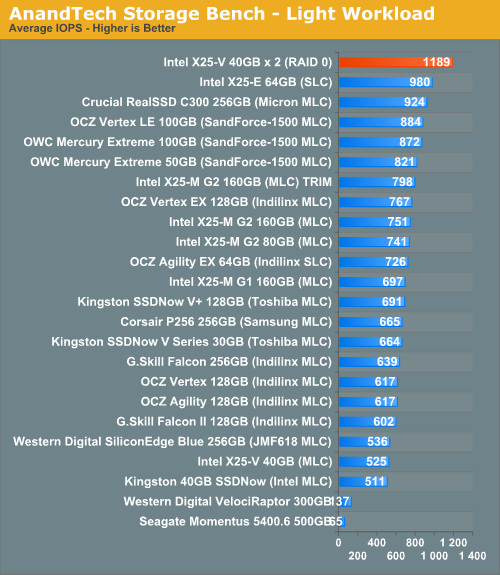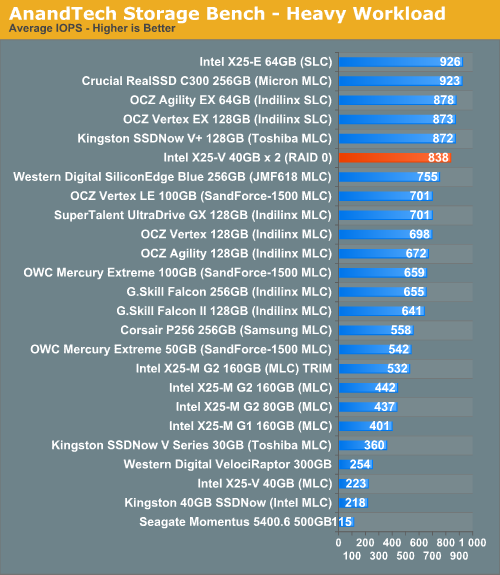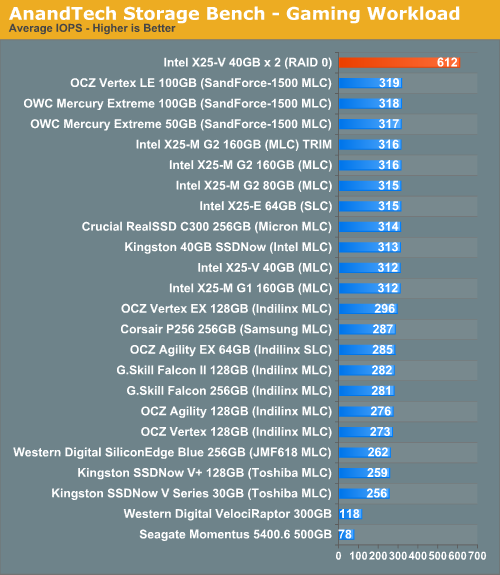Intel X25-V in RAID-0: Faster than X25-M G2 for $250?
by Anand Lal Shimpi on March 29, 2010 8:59 PM ESTAnandTech Storage Bench
The first in our benchmark suite is a light usage case. The Windows 7 system is loaded with Firefox, Office 2007 and Adobe Reader among other applications. With Firefox we browse web pages like Facebook, AnandTech, Digg and other sites. Outlook is also running and we use it to check emails, create and send a message with a PDF attachment. Adobe Reader is used to view some PDFs. Excel 2007 is used to create a spreadsheet, graphs and save the document. The same goes for Word 2007. We open and step through a presentation in PowerPoint 2007 received as an email attachment before saving it to the desktop. Finally we watch a bit of a Firefly episode in Windows Media Player 11.
There’s some level of multitasking going on here but it’s not unreasonable by any means. Generally the application tasks proceed linearly, with the exception of things like web browsing which may happen in between one of the other tasks.
The recording is played back on all of our drives here today. Remember that we’re isolating disk performance, all we’re doing is playing back every single disk access that happened in that ~5 minute period of usage. The light workload is composed of 37,501 reads and 20,268 writes. Over 30% of the IOs are 4KB, 11% are 16KB, 22% are 32KB and approximately 13% are 64KB in size. Less than 30% of the operations are absolutely sequential in nature. Average queue depth is 6.09 IOs.
The performance results are reported in average I/O Operations per Second (IOPS):

That's right. A pair of X25-Vs in RAID-0 offers better performance in our light workload than Crucial's RealSSD C300, a $799 drive. The performance scaling is more than perfect, but that's a side effect of the increase in capacity. Remember that Intel's controller uses any available space on the SSD as spare area to keep write amplification at a minimum. Our storage bench is based on a ~34GB image, which doesn't leave much room for the 40GB X25-V to keep write amplification under control. With two our total capacity is 74.5GB, which is more than enough for this short workload. With the capacity cap removed, the X25-Vs can scale very well. Not nearly twice the performance of an X25-M G2, but much faster than a single drive from Intel.
If there’s a light usage case there’s bound to be a heavy one. In this test we have Microsoft Security Essentials running in the background with real time virus scanning enabled. We also perform a quick scan in the middle of the test. Firefox, Outlook, Excel, Word and Powerpoint are all used the same as they were in the light test. We add Photoshop CS4 to the mix, opening a bunch of 12MP images, editing them, then saving them as highly compressed JPGs for web publishing. Windows 7’s picture viewer is used to view a bunch of pictures on the hard drive. We use 7-zip to create and extract .7z archives. Downloading is also prominently featured in our heavy test; we download large files from the Internet during portions of the benchmark, as well as use uTorrent to grab a couple of torrents. Some of the applications in use are installed during the benchmark, Windows updates are also installed. Towards the end of the test we launch World of Warcraft, play for a few minutes, then delete the folder. This test also takes into account all of the disk accesses that happen while the OS is booting.
The benchmark is 22 minutes long and it consists of 128,895 read operations and 72,411 write operations. Roughly 44% of all IOs were sequential. Approximately 30% of all accesses were 4KB in size, 12% were 16KB in size, 14% were 32KB and 20% were 64KB. Average queue depth was 3.59.

We see the same super scaling here thanks to the increase in capacity offered by RAIDing two of these drives together. The overall performance is great. We're at around 91% better performance than a single X25-M G2.
The gaming workload is made up of 75,206 read operations and only 4,592 write operations. Only 20% of the accesses are 4KB in size, nearly 40% are 64KB and 20% are 32KB. A whopping 69% of the IOs are sequential, meaning this is predominantly a sequential read benchmark. The average queue depth is 7.76 IOs.

As we saw in our sequential read tests, the X25-Vs in RAID-0 can do very well in sequential read workloads. Our game loading test has the X25-V RAID array beating even Crucial's 6Gbps RealSSD C300.










87 Comments
View All Comments
jed22281 - Friday, April 2, 2010 - link
@GullLarsCould you please explain to RoomRaider (down the bottom of pg 6) that there is no
TRIM support for RAID-0?
He keeps insisting there is throughout these comments....
He needs someone to explain why what he's citing as proof, is wrong.
Thanks if you can!
jed22281 - Friday, April 2, 2010 - link
Then again maybe he's right...http://www.tweaktown.com/articles/3116/tweaktown_s...
But his cited no's for knowing this to be true haven't sounded right to me yet.
Boofster - Tuesday, March 30, 2010 - link
It would be nice to see the X25-M G2 in RAID0 as well. Yes it is much more $ but still great value if you look at the performance. The 160gb will cost you ~$400 and possibly beat anything in this review. Of course you can say the same for the faster single drives in RAID0 as well but the value is lost.I can say for sure the Intel RAID tools do not let you TRIM the drive in RAID0 (X58 board). I am not sure if you temporarily drop the drive from the RAID, TRIM it, then put it back will work. Probably not because it will mess up the file system. I really hope Intel works this into their drivers as it is a very attractive option.
Can you also elaborate on the cleaning process? How do I accomplish this "secure data wipe"?
Hauraki - Tuesday, March 30, 2010 - link
There was a review on X-bit labs praised the v+ 2nd gen for home usage, and I'd like a second opinion from AnandTech. Thanks.nobita1168 - Tuesday, March 30, 2010 - link
Hai, i miss printed version , i like save to disk and read later, can anantech make a print version again? thanks
Ramon Zarat - Wednesday, March 31, 2010 - link
I don't know if the question has been asked before, but I'm wondering if TRIM will eventually be implemented for RAID or if it's technically impossible. If it's possible, any clue as of when it will happen?jed22281 - Saturday, April 3, 2010 - link
I would love to know this too! :(Roomraider - Wednesday, March 31, 2010 - link
After reading this review, I had to post: I'm running 2xM 160 g2's in Raid-0 with full trim support from Intels latest chipset drivers designed just for trim to raid support.So what gives here? Did someone not get the news about the new chipset drivers?
jed22281 - Saturday, April 3, 2010 - link
You are mistaken, there is not support for drives combined into RAID volumes.There is for individual drives connected to the controller while it's in RAID mode.
http://www.intel.com//support/chipsets/imsm/sb/CS-...
Also see
http://communities.intel.com/community/tech/solids...
Look for the gold star at the top of the page, select show details and then go to announcement 2.
"Intel® RST 9.6 supports TRIM in AHCI and pass through modes for RAID. A bug has been submitted to change the string that indicates TRIM is supported on RAID volumes (0, 1, 5, 10). Intel is continuing to investigate the ability of providing TRIM support for all RAID volumes in a future release."
buzznut - Thursday, April 1, 2010 - link
Thank you Anand!This is exactly what I've been looking for. I thought the performance would be better, but I had no idea it would be this good! I still see very little being written about these cost effective little drives. its good to know where to go for my SSD advice.
A quick question for anyone- My motherboard was running the drive (Intel x25-v) in ahci mode, but the mobo( Tforce ta790gx a2+) has never liked running in that mode and I started getting BSOD's after about two weeks. I had to switch back to ide mode, the board has always been quirky this way. Runs very smooth in IDE mode, no problems.
I had heard someone mention that trim doesn't work in ide mode, only while running the drive in ahci. If this is the case, then I will truly not miss trim when I get another drive and raid!
Can anyone confirm the loss of trim command in IDE mode? The intel toolbox seems to work just fine when I run the weekly optimizer.